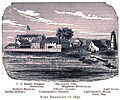| DescriptionFort Dearborn in 1850.jpg |
The above is a very good representation of the Fort, in 1850, from a daguerrotype, by Polycarpus von Schneidau, a Swedish nobleman, taken from
the south front of the Lake House, which was situated on the east side of Rush Street, extending from Michigan to Kinzie (now called North- Water)
Streets. The ferry, shown in the foreground, landed on the North-Side, about where the " Empire Warehouse " now is. The building faintly shown
between the block-house and the light-keeper's, is the residence of the late "Judge" Henry Fuller, and was just outside of the Fort enclosure, and the
ground is now covered by Spaulding & Merrick's tobacco works. There was another building in the Fort enclosure, not shown in this view, just east of
the block-house; were the officers' quarters in this view removed, it would appear as if in front of the large locust-tree, and was the quartermaster's or
sutler's quarters. The parade-ground was between the commandant's, officers', and sutler's quarters on the west, and the building where the artillery
was housed, the soldier's barracks, and the storehouse on the east; and was about 80 feet wide, and extended from the river bank south, the full length
of the enclosure — say 400 feet; near its southern extremity was a gentle rise of ground or knoll, in the centre of which was an 8-inch piece of square
timber, imbedded in the earth, placed upright, about 2 feet high, upon the top of which was a brass plate on which had been a sun-dial. South of this
sun-dial, say 100 feet, was a turn-style through which you entered the P'ort enclosure from the centre of Michigan Avenue, which then commenced at this
point. The whole Fort enclosure was surrounded by a rough-board fence, white-washed, about 6 feet high; the pickets having been removed at an
earlier date. The kitchen-garden was in the south-west corner of the enclosure and with it made more hearts merry than any man who ever lived
in Chicago. |

